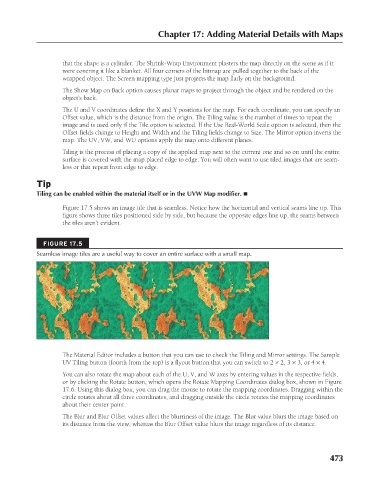Page 521 - Kitab3DsMax
P. 521
Chapter 17: Adding Material Details with Maps
that the shape is a cylinder. The Shrink-Wrap Environment plasters the map directly on the scene as if it
were covering it like a blanket. All four corners of the bitmap are pulled together to the back of the
wrapped object. The Screen mapping type just projects the map flatly on the background.
The Show Map on Back option causes planar maps to project through the object and be rendered on the
object’s back.
The U and V coordinates define the X and Y positions for the map. For each coordinate, you can specify an
Offset value, which is the distance from the origin. The Tiling value is the number of times to repeat the
image and is used only if the Tile option is selected. If the Use Real-World Scale option is selected, then the
Offset fields change to Height and Width and the Tiling fields change to Size. The Mirror option inverts the
map. The UV, VW, and WU options apply the map onto different planes.
Tiling is the process of placing a copy of the applied map next to the current one and so on until the entire
surface is covered with the map placed edge to edge. You will often want to use tiled images that are seam-
less or that repeat from edge to edge.
Tip
Tiling can be enabled within the material itself or in the UVW Map modifier. n
Figure 17.5 shows an image tile that is seamless. Notice how the horizontal and vertical seams line up. This
figure shows three tiles positioned side by side, but because the opposite edges line up, the seams between
the tiles aren’t evident.
FIGURE 17.5
Seamless image tiles are a useful way to cover an entire surface with a small map.
The Material Editor includes a button that you can use to check the Tiling and Mirror settings. The Sample
UV Tiling button (fourth from the top) is a flyout button that you can switch to 2 × 2, 3 × 3, or 4 × 4.
You can also rotate the map about each of the U, V, and W axes by entering values in the respective fields,
or by clicking the Rotate button, which opens the Rotate Mapping Coordinates dialog box, shown in Figure
17.6. Using this dialog box, you can drag the mouse to rotate the mapping coordinates. Dragging within the
circle rotates about all three coordinates, and dragging outside the circle rotates the mapping coordinates
about their center point.
The Blur and Blur Offset values affect the blurriness of the image. The Blur value blurs the image based on
its distance from the view, whereas the Blur Offset value blurs the image regardless of its distance.
473
6/30/10 4:25 PM
25_617779-ch17.indd 473
25_617779-ch17.indd 473 6/30/10 4:25 PM

